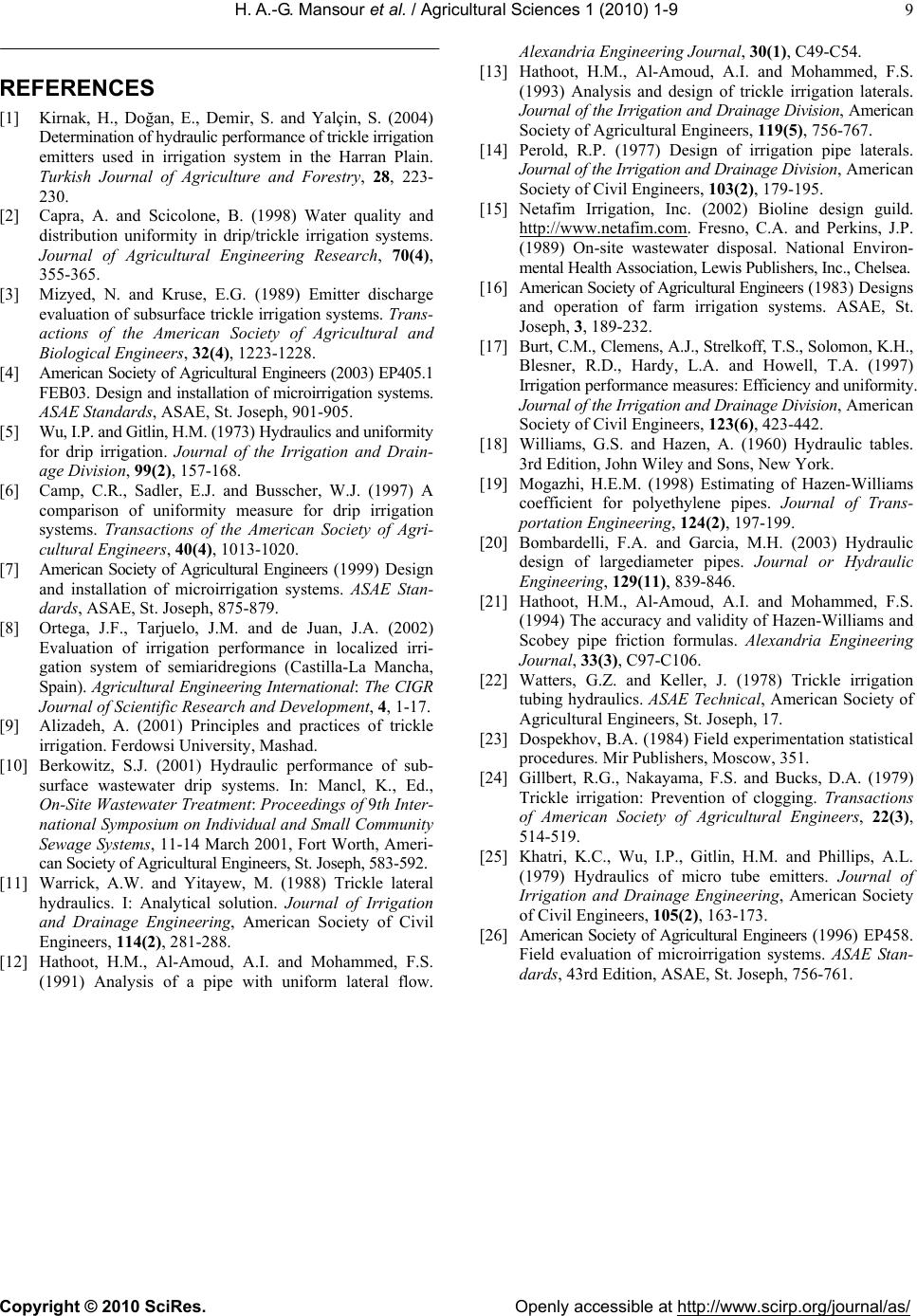
H. A.-G. Mansour et al. / Agricultural Sciences 1 (2010) 1-9
Copyright © 2010 SciRes. Openly accessible at http://www.scirp.org/journal/as/
9
REFERENCES
[1] Kirnak, H., Doğan, E., Demir, S. and Yalçin, S. (2004)
Determination of hydraulic performance of trickle irrigation
emitters used in irrigation system in the Harran Plain.
Turkish Journal of Agriculture and Forestry, 28, 223-
230.
[2] Capra, A. and Scicolone, B. (1998) Water quality and
distribution uniformity in drip/trickle irrigation systems.
Journal of Agricultural Engineering Research, 70(4),
355-365.
[3] Mizyed, N. and Kruse, E.G. (1989) Emitter discharge
evaluation of subsurface trickle irrigation systems. Trans-
actions of the American Society of Agricultural and
Biological Engineers, 32(4), 1223-1228.
[4] American Society of Agricultural Engineers (2003) EP405.1
FEB03. Design and installation of microirrigation systems.
ASAE Standards, ASAE, St. Joseph, 901-905.
[5] Wu, I.P. and Gitlin, H.M. (1973) Hydraulics and uniformity
for drip irrigation. Journal of the Irrigation and Drain-
age Division, 99(2), 157-168.
[6] Camp, C.R., Sadler, E.J. and Busscher, W.J. (1997) A
comparison of uniformity measure for drip irrigation
systems. Transactions of the American Society of Agri-
cultural Engineers, 40(4), 1013-1020.
[7] American Society of Agricultural Engineers (1999) Design
and installation of microirrigation systems. ASAE Stan-
dards, ASAE, St. Joseph, 875-879.
[8] Ortega, J.F., Tarjuelo, J.M. and de Juan, J.A. (2002)
Evaluation of irrigation performance in localized irri-
gation system of semiaridregions (Castilla-La Mancha,
Spain). Agricultural Engineering International: The CIGR
Journal of Scientific Research and Development, 4, 1-17.
[9] Alizadeh, A. (2001) Principles and practices of trickle
irrigation. Ferdowsi University, Mashad.
[10] Berkowitz, S.J. (2001) Hydraulic performance of sub-
surface wastewater drip systems. In: Mancl, K., Ed.,
On-Site Wastewater Treatment: Proceedings of 9th Inter-
national Symposium on Individual and Small Community
Sewage Systems, 11-14 March 2001, Fort Worth, Ameri-
can Society of Agricultural Engineers, St. Joseph, 583-592.
[11] Warrick, A.W. and Yitayew, M. (1988) Trickle lateral
hydraulics. I: Analytical solution. Journal of Irrigation
and Drainage Engineering, American Society of Civil
Engineers, 114(2), 281-288.
[12] Hathoot, H.M., Al-Amoud, A.I. and Mohammed, F.S.
(1991) Analysis of a pipe with uniform lateral flow.
Alexandria Engineering Journal, 30(1), C49-C54.
[13] Hathoot, H.M., Al-Amoud, A.I. and Mohammed, F.S.
(1993) Analysis and design of trickle irrigation laterals.
Journal of the Irrigation and Drainage Division, American
Society of Agricultural Engineers, 119(5), 756-767.
[14] Perold, R.P. (1977) Design of irrigation pipe laterals.
Journal of the Irrigation and Drainage Division, American
Society of Civil Engineers, 103(2), 179-195.
[15] Netafim Irrigation, Inc. (2002) Bioline design guild.
http://www.netafim.com. Fresno, C.A. and Perkins, J.P.
(1989) On-site wastewater disposal. National Environ-
mental Health Association, Lewis Publishers, Inc., Chelsea.
[16] American Society of Agricultural Engineers (1983) Designs
and operation of farm irrigation systems. ASAE, St.
Joseph, 3, 189-232.
[17] Burt, C.M., Clemens, A.J., Strelkoff, T.S., Solomon, K.H.,
Blesner, R.D., Hardy, L.A. and Howell, T.A. (1997)
Irrigation performance measures: Efficiency and uniformity.
Journal of the Irrigation and Drainage Division, American
Society of Civil Engineers, 123(6), 423-442.
[18] Williams, G.S. and Hazen, A. (1960) Hydraulic tables.
3rd Edition, John Wiley and Sons, New York.
[19] Mogazhi, H.E.M. (1998) Estimating of Hazen-Williams
coefficient for polyethylene pipes. Journal of Trans-
portation Engineering, 124(2), 197-199.
[20] Bombardelli, F.A. and Garcia, M.H. (2003) Hydraulic
design of largediameter pipes. Journal or Hydraulic
Engineering, 129(11), 839-846.
[21] Hathoot, H.M., Al-Amoud, A.I. and Mohammed, F.S.
(1994) The accuracy and validity of Hazen-Williams and
Scobey pipe friction formulas. Alexandria Engineering
Journal, 33(3), C97-C106.
[22] Watters, G.Z. and Keller, J. (1978) Trickle irrigation
tubing hydraulics. ASAE Technical, American Society of
Agricultural Engineers, St. Joseph, 17.
[23] Dospekhov, B.A. (1984) Field experimentation statistical
procedures. Mir Publishers, Moscow, 351.
[24] Gillbert, R.G., Nakayama, F.S. and Bucks, D.A. (1979)
Trickle irrigation: Prevention of clogging. Transactions
of American Society of Agricultural Engineers, 22(3),
514-519.
[25] Khatri, K.C., Wu, I.P., Gitlin, H.M. and Phillips, A.L.
(1979) Hydraulics of micro tube emitters. Journal of
Irrigation and Drainage Engineering, American Society
of Civil Engineers, 105(2), 163-173.
[26] American Society of Agricultural Engineers (1996) EP458.
Field evaluation of microirrigation systems. ASAE Stan-
dards, 43rd Edition, ASAE, St. Joseph, 756-761.